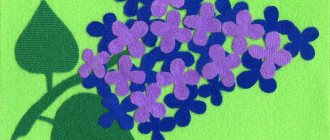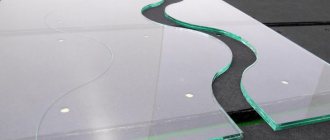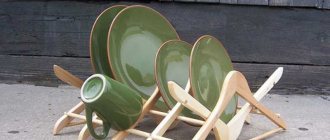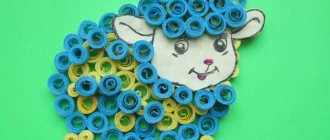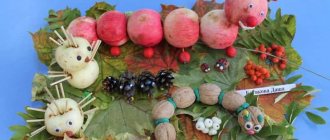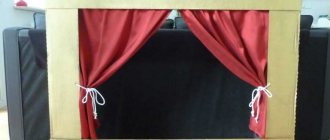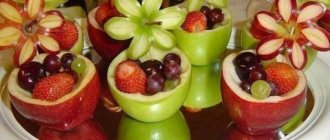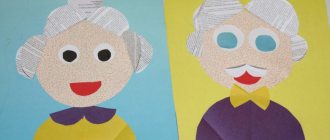Best crafts for elementary school
Primary school students enjoy creating various crafts with their own hands. Children are especially interested in working with non-traditional materials.
Fringe
It’s not difficult to make corrugated numbers yourself; you just need to buy corrugation in the desired shades. Place a cut ribbon of medium width and length in your hand, slightly stretching one corner to obtain a wave effect.
It’s very easy to make a beautiful flower from a strip: using gentle movements at an angle, we twist the rose around the prepared corner.
Eventually a bud on a stalk should appear. We attach the rose to the frame base with glue and leave it to dry in a secluded place.
Village of gnomes
An excellent craft option for elementary school would be making a fairytale village from toilet paper rolls.
To work you need to prepare:
- 6 toilet paper rolls,
- PVA glue,
- colored and white paper,
- paints,
- scissors,
- brush.
Operating procedure.
- The bushings must be cut in half; this is the basis of the house.
- Cut out 6 rectangular blanks for wall decoration from white paper, draw colored windows and doors on them.
- Glue the halves of the bushings with the resulting parts, carefully bending the edges inside the cylinders.
- Cut out and glue roof cones from colored paper.
- Glue the roofs.
- Attach the houses to a cardboard base and add a spruce cone to the village.
The original gnome village is ready.
Snowmen made from cotton pads
Winter crafts for school can be made from various available materials. Cotton pads are convenient for children's creativity; they are easy to glue and easy to color.
To create a cute snowman you will need:
- three cotton pads,
- large ice cream stick,
- glue,
- a piece of felt for a headdress,
- beads for decoration,
- colored yarn or scrap for a scarf.
Operating procedure.
- Cut out three cardboard circles and stick cotton pads on them. Glue the blanks onto the stick one by one, starting from the bottom.
- Decorate the character's face using beads, plasticine or colored paper.
- Cut and glue a hat or stylized felt bucket.
- Tie a bright scarf to the snowman.
A funny snowman will serve as an excellent decoration for a classroom or school Christmas tree. Using cotton pads as a basis, you can make a voluminous Christmas tree or a festive cupcake from them.
Paper flowers for covering
The original numbers made from corrugated paper look very nice. They are made like this: a cardboard base is covered with paper roses.
We cut strips of the same size, approximately 5 cm wide, up to 50 cm long. The shorter the length of the strip, the smaller each flower will be, therefore, more of them will be needed.
We bend the edge of the strip half a centimeter, roll it into a roll, tie it with thread at the bottom, the rose is ready. You need to make enough of them to completely cover the entire craft.
Christmas toys made from old CDs
Shiny discs that have fallen into disrepair can also be taken to school as the basis for New Year's crafts.
There are many options for designing a New Year's toy based on a disk.
Using the rounded shape of the disk, it’s easy to make figures of different animals or funny characters from the cartoon “Smeshariki”. Templates for making parts are easy to copy on the Internet.
You can glue small elements made of white paper using the quilling technique onto the surface of the disk. To make parts, you need to cut the paper into narrow ribbons and twist it into a spiral.
Using a similar technique, you can create unusual panels depicting a Christmas tree or a winter picture.
Preparation of natural materials for their further use
Nature is the best artist; she creates natural materials that, in skillful hands, turn into works of art!
Plant materials
Chestnuts
Chestnut fruits have a bright brown color and a shiny surface, so they make excellent DIY crafts from natural materials. The shell of a fresh chestnut is thin and can be easily pierced with an awl. Chestnuts are a fertile material for working with young children themselves. You can make many different pupae, animals and insects.
It is better to store in a cool place in boxes.
Acorns
Oak fruits ripen in autumn, in September-October. Acorns are collected in various shapes and sizes.
At the same time, their cups (pluses) on which they rest are collected. Pluski are very often used separately from acorns, as an independent natural material for various crafts.
Acorn pluses and balls felted from wool
How to felt even balls of wool, see Olga Skibina’s :
Acorn tops and Christmas bells
Photo frame made from plush acorns
Photo frame made from whole acorns
In addition to acorns, this topiary contains nuts, chestnuts and cones:
Acorns are stored in a damp and cool place. To make toys, it is better to use fresh acorns (overdried acorns quickly split during work).
Cones and needles
Cones are often used to imitate the torso of animals or birds, people or fictional characters. For work, it is best to use unopened cones, because they are much easier to work with.
In Nika Shvetsova’s you will see how to make these deer from twigs and cones together with your children:
And here’s how to make the cutest hedgehog from pine cones from the ChameleonArtStudio :
Penguins made of cones and wooden beads
Gnomes made of cones, wooden beads and felt
Pine cones should be collected on moist soil (this way they are better preserved), and then arranged in boxes according to type, shape, and size.
See how to make a bouquet of roses from pine cones on the channel Crafts for kindergarten and school :
MASTER CLASS ON THE TOPIC DIY autumn crafts from pine cones
Needles can be collected at any time of the year in coniferous forests near pines, spruces, and cedar. It is very often used as an addition to the making of toys: butterfly antennae, hedgehog needles, doll skirts, etc. It is better to use green pine needles in your work.
Nuts
In your work you can use walnuts, hazelnuts, pine nuts, groundnuts, pistachios .
Pistachio artichoke
Pistachio topiary
mature hazelnuts together with the cap (plush), which can then be used in making toys. The nuts are dried and stored in boxes.
Hazelnut shells are hard. It is difficult to cut with a knife or pierced with an awl. Overdried nuts are difficult to work with.
Wreath of pine cones
Pine nuts are indispensable for making animal paws; they stick together well and are easily pierced.
Whole walnuts make delicious berries and fruits:
Strawberries made from walnuts
Pineapple with walnuts
And also magical New Year's decor:
the walnut shells into two halves using a knife, inserting its tip into the hole between the shells. Walnut shells are durable, they are quite easily transformed into turtles, bugs, small rodents, spiders and are even suitable for creating cute little boats!
Leaves and seeds
It is better to collect leaves in the fall, when they are especially beautiful. Leaves of oak, maple, and chestnut can be used to create all kinds of applications:
Birds made from leaves
Insects from leaves
Elephant made of leaves
The shells of these snails are made according to the principle of assembling a rose from leaves:
Examples of other leaf applications:
Wreaths made of bright leaves are the most atmospheric autumn decor!
This option for assembling a wreath is much simpler than the previous one - even children can handle it:
For long-term storage, the collected leaves are placed between paper sheets and ironed with a warm iron. Then they are laid out with old newspapers, thin cardboard and pressed down on top with a small weight.
Grass, moss, poplar fluff
Dried grass is used to connect the parts of the craft, but it is worth considering that when it dries, it becomes brittle and sometimes very sharp.
Moss is used to convey the background and image of vegetation. It sticks perfectly with any glue.
YOU WILL NEED Crafts made from poplar fluff and paintings made from plants
Bark
Tree bark varies in color, thickness, and surface structure. It can be used as a stand for making scenes, as an additional material or as the basis for a craft.
Attention! When collecting natural materials, you need to teach children to respect nature and follow the main rule of behavior: “Do no harm!”
Birch bark is birch bark, very beautiful toys and decorations are made from it.
It is advisable to collect it in spring and summer, but only from birch trees and branches that have been cut down or fallen by a storm. The removed birch bark 20-25 cm wide is cleaned of dirt, moss, and the outside is also cleaned with sandpaper. It needs to be steamed in hot water and placed under a board with a weight.
The bark should be stored in a dry and cool place.
Twigs, sticks, wooden cuts
It is best to collect twigs of pine, spruce, lilac, and dogwood. They are elastic and do not break easily when dry. They are often used in the manufacture of little animals and men as legs, necks, arms, horns, etc. (examples are given above in this article).
However, ordinary branches and sticks can also be used as an independent decorative element, while the crafts look very stylish and are incredibly easy to make:
Painted wooden sticks
Garland of wooden sticks
Dream catchers made of feathers and branches
Garland of feathers and branches
A little more patience and dexterity will be needed to make marine-themed crafts from branches and other available materials:
Branch raft
Ship made of boards and branches
Beach house and lighthouse made from painted wooden sticks
Wooden saw cuts are also often used for DIY crafts and interior decoration.
Minimalistic drawings look very interesting!
New Year's crafts from wooden cuts
The little ones can draw Santa Clauses)
And this is the work of a real master!
Photo frame or mirror frame? You decide. Channel One shares a video lesson with us :
Mineral materials
Pebbles
Stones of all shapes, colors and sizes are used to create crafts. Children especially love to collect pebbles near a river or sea, and then with the help of their parents, as well as brushes, paints and varnish, they can create various images on the pebbles.
You can store them for a very long time, after thoroughly washing and drying them. But why just store stones when the whole family can have fun playing with them?)
YOU WILL NEED IT
Miracle painting: turning a sea pebble into a cactus
For another way to apply images to river or sea stones, see the video from You Can Do It Craft . You'll be surprised how easy it is!
Shells
You can collect shells on the banks of rivers, seas, and lakes while relaxing with your children. Many of them are original in appearance, shape - oval, scallop-shaped, elongated, etc.
Boil them for a few minutes to free them from living organisms. The shells are washed with a small brush (or a toothbrush), after which they are dried and sorted by type and size. Stored at any temperature.
You can also clean shells in a solution of bleach and water at a ratio of 1:1. The top layer will disappear after a while, leaving the shell with a beautiful shiny top.
Animal figures are made from large shells.
Small shells make wonderful applications, photo frames, garlands:
Shells can be used not only as the main material, but also as additional decoration (bird wings, dog ears, flower petals, etc.)
Sand
Very accessible material that can be collected in any sandbox. It varies in structure. Before use, it must be rinsed and dried thoroughly. And then you can use it as decoration in your works:
Rules for storing natural materials
DIY crafts made from natural materials will be flawless if, after collecting, drying, and pre-processing, you properly store these natural gifts. To do this, you must adhere to certain rules.
- A dark, cool and well-ventilated area is the best place to store natural materials.
- You can buy plastic containers to store each type of material; use cardboard boxes for shoes, tea, sweets; take ordinary glass jars with a screw cap. For seeds, as for beads, it is better to have a container with many compartments.
- Dried flowers are fragile and break easily, so they are placed in a tight box or container. Petals are stored separately from flowers. Flowers with stems can be stored in a vase.
- Prepared leaves are also brittle. You can store them in large books. Also, for safety, put them in labeled candy boxes, secure them with a little tape so that they don’t accidentally open.
- The shells are placed in glass jars or plastic containers with a wide mouth to prevent them from crumbling.
Additional tools for crafts made from natural materials
To create a beautiful craft from natural materials, you will need additional tools and materials.
It can be:
- colored paper;
- cardboard;
- leather scraps;
- scraps of fabric;
- bird feathers;
- Styrofoam;
- plasticine;
- wire;
- PVA glue, “Moment”;
- gouache;
- stain;
- varnish, etc.
Paper is very often used as a complement to natural materials. Children, bending and gluing it, make the work much more interesting.
Plasticine is used to hold together individual parts of simple toys at the initial stage of work. It is not very durable, but as an addition it is often used in kindergarten and elementary school.
The frame of a toy and the connection of its parts are most often made from wire Copper wire with a diameter of 0.29-0.35 mm - soft, flexible and durable - is most convenient. And for the frame, wire of a larger diameter is used - 1-1.5 mm.
It is better to take thick, multi-colored threads
glue . However, in kindergarten it is better to use PVA glue.
They also use foil, pebbles, cherry pits, and bristles.
It is better to store additional material in a small box with compartments for each type of material.
The use of additional material depends on the plan, the skill of the children, and the degree of development of imagination! Offer your options, but rely more on children's intuition and desire.
It is also additionally necessary to have certain tools for making crafts from natural materials:
- knife;
- art scissors;
- awl;
- jigsaw;
- tweezers;
- pliers and wire cutters;
- sewing needles;
- brushes for glue and paints;
- a cotton cloth for wiping off glue residue.
Scissors for children should have blunt ends, small, and have rings that are comfortable for a child's hand.
The awl should be made of durable material with a handle length of about 6 cm, a diameter of about 2 cm, and the piercing part is 3.5 cm.
needle . Be sure to store it in a pincushion with a thread threaded into it.
Attention! Only adults use pliers, pliers, and drills!
To draw the outline of the cut part, you need a simple pencil . For example, a dress, hats for a doll, etc. It is better to take a soft pencil (2M).
paints in special sets.
Brushes (soft for painting, harder for glue). It is better to buy squirrel tassels (No. 4 and 6). For glue, use brushes with hard bristles.
A stack is a tool necessary for processing a surface made of clay or plasticine. The length of the stack for children is about 12 cm. You can make the stack yourself from a worn-out brush: round it on one side and sharpen it on the other.
Crafts made from salt dough
New Year's crafts for school are easy to make from salt dough.
In order to make the dough, you need to mix salt and flour in equal proportions, adding 1/2 part of water.
The result is a plastic mass, ideal for modeling.
Having rolled out the dough into an even layer, it is easy to cut out any figure from it according to the template. It could be Santa Claus, a snowman, a Christmas tree, a gnome.
The dough is dried in the open air or in the oven, then the workpiece is painted with gouache. For durability, the craft can be coated with colorless varnish.
If you roll the dough into neat sausages, then these parts will make an openwork snowflake.
Such crafts can be hung on a string and used to decorate a school Christmas tree.
It’s easy to make three-dimensional crafts from salt dough: a Christmas tree, a hedgehog, Santa Claus.
Lush flowers made from napkins
To do this, take two-layer napkins. Next, fold the napkin to form a square. This square must be cut around the edges to obtain a circle.
If desired, you can make the edges wavy. You need to put a stapler in the center of the circle.
To increase the volume of such a flower, it is good to use two or three napkins at once instead of one.
This multi-layered circle is the template for the flower. The volume of the flower depends on the number of layers. Now gradually lift each layer up, pressing towards the middle.
After this, straighten the resulting structure. You will get a lush flower. You will need quite a large number of such flowers.
Crafts made from glue and threads
Taking bright yarn or linen cord and PVA glue, it’s easy to make interesting options for Christmas tree decorations.
In order to create a ball of thread, you will need a balloon, on which a thread soaked in glue will be wound.
After the thread has dried, the ball is pierced, and its remains are carefully removed from the craft. The ball can be decorated with beads, beads or ribbons.
A Christmas tree craft made from thread and glue for school can have any shape.
To give the desired shape, threads soaked in glue are fixed with pins on the flat surface of a disposable plastic tray. After drying, the product can be further decorated. Using this technique, you can make a snowflake or a star.
Where and how to place the number
A large, thick craft can be placed directly on the floor or you can allocate a stool for it. During manufacturing, the lower part of the product must be weighted to give stability by gluing, for example, wooden blocks inside.
If the figurine is flat and cannot stand on its own, you need to provide a loop on the back side to hang the figure on the wall or ensure a vertical position in another way, for example, when making it, provide it with a stick and place it in a vase.
After the holiday, a beautiful craft can be placed in the interior for a whole year - on the wall or on the desktop.
House made of paper tubes
An interesting house is made using paper tubes. To make the tubes themselves, paper or newspaper is cut into long strips, from which the tubes are twisted by winding them on a knitting needle or pencil. The edges are fixed with glue.
The log hut is formed from the resulting blanks. The roof is easy to make from cardboard.
The door and windows are cut out of paper and glued to the blank.
The house made from newspaper tubes must be painted with acrylic paint.
It’s easy to weave a basket or vase from the tubes, using a glass or jar as a basis for work.
Origami
Easy-to-work paper serves as a traditional material for children's crafts. It makes excellent Christmas tree garlands and original toys.
Depending on the age of the child, you can use different techniques for working with paper.
Primary school students will enjoy making simple chains from colored paper and lanterns to decorate the school Christmas tree.
Middle school students can make crafts using the origami technique, for example, a star or an animal figurine.
You can create interesting holiday cards using the quilling technique with your own hands using glue and colored paper.
Flat digit
It is much faster and easier to make a figure yourself in a flat version. If you use your imagination, the craft will look no less impressive than a voluminous one.
The design options are varied: paint it, cover it with colored paper or foil, cover it with fabric, and if you also cover it with flowers, they will add some volume.
Crafts from waste material
Using waste material as a basis for children's creativity will help draw children's attention to the problem of environmental pollution.
Used light bulbs can be used as feedstock. You can make interesting Christmas tree decorations from them by coloring and additional decor.
Soft figure
There is another way to add volume to the product. The cardboard base is wrapped in fabric or inserted into a sewn cover, and padding material - centipon, foam rubber or cotton wool - is added under the fabric.
We recommend reading:
A paper crown is a simple instruction for creating original jewelry with your own hands. Templates, diagrams, master class, exclusive design (110 photos)- Weaving from newspaper tubes for beginners: the best free master class, with step-by-step instructions. Photos, diagrams, unusual ideas, videos
Paper rose - how to make it yourself? Step-by-step instructions, original ideas, photos, videos, master class
The figurine will become round and soft to the touch; your baby will surely like this figure.
Santa Claus from a light bulb
It’s easy to use a regular incandescent lamp to create a New Year’s craft.
To work you need to prepare:
- salt dough or plasticine,
- light bulb
- paints,
- brush,
- lace,
- glue.
Operating procedure.
- Form the head and hands of Santa Claus from the modeling mixture and glue to the base light bulb.
- Make a hole in the top for the lace.
- Paint the workpiece with gouache or acrylic paint.
- After drying, hang it on a string.
Creating decor from napkins
The simplest and most understandable option is lush flowers. You can fill the front side of the frame with one color or apply a gradient.
Creative imagination and festive mood are the best advisers in resolving this issue.
Crafts for school anniversary
A school holiday dedicated to the anniversary of an educational institution cannot do without themed crafts.
As a gift to your favorite school, you can make a beautiful postcard with your own hands, using the quilling technique.
Do-it-yourself school day crafts can also be a group effort. For example, a colorful collage reflecting the theme of school everyday life or a large A3 calendar in a beautiful frame.
A memorable gift will be an album or wall newspaper with a selection of poems and photographs of students, as well as a bright congratulatory poster.
Crafts for school involve a lot of creative ideas and the use of different techniques to make them. The active participation of children in the creative process will serve as a good basis for their diversified development.
Other ideas
Materials for winter crafts can be threads, felt, felt, lace and satin ribbons - any textile. There is a use for popsicle sticks and toothpicks. Cotton pads and just cotton wool will look great. The main thing is to look at waste materials from a different angle.
You can add extra shine to your work with shiny nail polish and loose glitter. If you don’t have them on hand, you can simply finely chop tinsel or rain.

